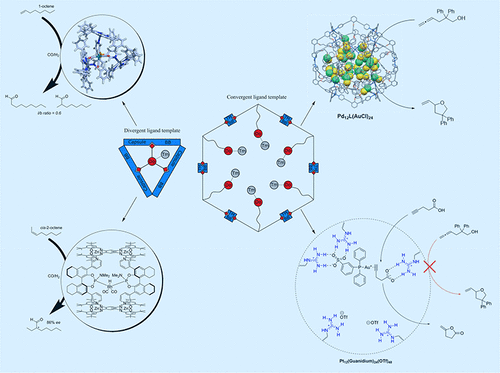当前位置:
X-MOL 学术
›
Acc. Chem. Res.
›
论文详情
Our official English website, www.x-mol.net, welcomes your
feedback! (Note: you will need to create a separate account there.)
Ligand Template Strategies for Catalyst Encapsulation.
Accounts of Chemical Research ( IF 16.4 ) Pub Date : 2018-08-23 , DOI: 10.1021/acs.accounts.8b00345 Lukas J Jongkind 1 , Xavier Caumes 1 , Arnout P T Hartendorp 1 , Joost N H Reek 1
Accounts of Chemical Research ( IF 16.4 ) Pub Date : 2018-08-23 , DOI: 10.1021/acs.accounts.8b00345 Lukas J Jongkind 1 , Xavier Caumes 1 , Arnout P T Hartendorp 1 , Joost N H Reek 1
Affiliation

|
Binding of molecules in molecular cages based on self-assembled concave building blocks has been of great interest to scientists for decades. The binding of static molecular fragments inside cage-like molecular structures is generally based on complementarity of host and guest in terms of shape and interactions. The encapsulation of homogeneous catalysts in molecular cages is of interest as activity, selectivity, and stability can be controlled by the cage as second coordination sphere, reminiscent of how enzymes control chemical reactivity. Homogeneous catalysts, however, are not static guest molecules as catalysts change in shape, charge, and polarity during the catalytic cycle, representing the challenges involved in cage controlled catalysis. To address these issues, we developed a new strategy that we coined the "ligand template approach for catalyst encapsulation". This strategy relies on ligand building blocks that contain multiple orthogonal binding sites: the central ligand (mostly phosphorus) is bound to the transition metal required for catalysis, while other binding sites are used to construct a cage structure around the transition metal atom through self-assembly. By design, the catalyst is inside the capsule during the catalytic cycle, as the central ligand is coordinated to the catalyst. As the approach is based on a self-assembly process of building blocks, the catalyst properties can be easily modulated by modification of building blocks involved. In this Account, we elaborate on template ligand strategies for single catalyst encapsulation, based on divergent ligand templates and the extension to nanospheres with multiple metal complexes, which are formed by assembly of convergent ligand templates. Using the mononuclear approach, a variety of encapsulated catalysts can be generated, which have led to highly (enantio)selective hydroformylation reactions for encapsulated rhodium atoms. Besides the successes of encapsulated rhodium catalysts in hydroformylation, mononuclear ligand template capsules have been applied in asymmetric hydrogenation, the Heck reaction, copolymerization, gold catalyzed cyclization reactions, and hydrosilylation reactions. By changing the capsule building blocks the electronic and steric properties around the transition metal atom have successfully been modified, which translates to changes in catalyst properties. Using the convergent ligand templates, nanospheres have been generated with up to 24 complexes inside the sphere, leading to very high local concentrations of the transition metal. The effect of local concentrations was explored in gold catalyzed cyclization reactions and ruthenium catalyzed water oxidation, and for both reactions, spectacular reaction rate enhancements have been observed. This Account shows that the template ligand approach to provide catalyst in well-defined specific environments is very versatile and leads to catalyst properties that are not achievable with traditional approaches.
中文翻译:

催化剂封装的配体模板策略。
几十年来,基于自组装凹结构单元的分子笼中的分子结合一直引起了科学家的极大兴趣。笼状分子结构内静态分子片段的结合通常基于主体和客体在形状和相互作用方面的互补性。将均相催化剂封装在分子笼中是令人感兴趣的,因为活性、选择性和稳定性可以通过作为第二配位层的笼来控制,让人想起酶如何控制化学反应性。然而,均相催化剂并不是静态的客体分子,因为催化剂在催化循环过程中形状、电荷和极性会发生变化,这代表了笼控催化所面临的挑战。为了解决这些问题,我们开发了一种新策略,我们创造了“催化剂封装的配体模板方法”。该策略依赖于包含多个正交结合位点的配体构件:中心配体(主要是磷)与催化所需的过渡金属结合,而其他结合位点用于通过自结合在过渡金属原子周围构建笼结构。集会。根据设计,催化剂在催化循环期间位于胶囊内部,因为中心配体与催化剂配位。由于该方法基于构件的自组装过程,因此可以通过修改所涉及的构件来轻松调节催化剂性能。在本报告中,我们基于不同的配体模板和对具有多种金属配合物的纳米球的扩展(通过聚合配体模板组装形成),详细阐述了单催化剂封装的模板配体策略。 使用单核方法,可以生成多种封装催化剂,从而导致封装铑原子的高度(对映)选择性加氢甲酰化反应。除了封装铑催化剂在加氢甲酰化中的成功外,单核配体模板胶囊已应用于不对称氢化、Heck反应、共聚、金催化环化反应和氢化硅烷化反应。通过改变胶囊构建块,过渡金属原子周围的电子和空间性质已成功改变,这转化为催化剂性质的变化。使用会聚配体模板,生成了纳米球,球内有多达 24 个复合物,导致过渡金属的局部浓度非常高。在金催化环化反应和钌催化水氧化反应中探索了局部浓度的影响,并且对于这两种反应,都观察到了惊人的反应速率增强。该帐户表明,在明确定义的特定环境中提供催化剂的模板配体方法非常通用,并导致传统方法无法实现的催化剂特性。
更新日期:2018-08-23
中文翻译:

催化剂封装的配体模板策略。
几十年来,基于自组装凹结构单元的分子笼中的分子结合一直引起了科学家的极大兴趣。笼状分子结构内静态分子片段的结合通常基于主体和客体在形状和相互作用方面的互补性。将均相催化剂封装在分子笼中是令人感兴趣的,因为活性、选择性和稳定性可以通过作为第二配位层的笼来控制,让人想起酶如何控制化学反应性。然而,均相催化剂并不是静态的客体分子,因为催化剂在催化循环过程中形状、电荷和极性会发生变化,这代表了笼控催化所面临的挑战。为了解决这些问题,我们开发了一种新策略,我们创造了“催化剂封装的配体模板方法”。该策略依赖于包含多个正交结合位点的配体构件:中心配体(主要是磷)与催化所需的过渡金属结合,而其他结合位点用于通过自结合在过渡金属原子周围构建笼结构。集会。根据设计,催化剂在催化循环期间位于胶囊内部,因为中心配体与催化剂配位。由于该方法基于构件的自组装过程,因此可以通过修改所涉及的构件来轻松调节催化剂性能。在本报告中,我们基于不同的配体模板和对具有多种金属配合物的纳米球的扩展(通过聚合配体模板组装形成),详细阐述了单催化剂封装的模板配体策略。 使用单核方法,可以生成多种封装催化剂,从而导致封装铑原子的高度(对映)选择性加氢甲酰化反应。除了封装铑催化剂在加氢甲酰化中的成功外,单核配体模板胶囊已应用于不对称氢化、Heck反应、共聚、金催化环化反应和氢化硅烷化反应。通过改变胶囊构建块,过渡金属原子周围的电子和空间性质已成功改变,这转化为催化剂性质的变化。使用会聚配体模板,生成了纳米球,球内有多达 24 个复合物,导致过渡金属的局部浓度非常高。在金催化环化反应和钌催化水氧化反应中探索了局部浓度的影响,并且对于这两种反应,都观察到了惊人的反应速率增强。该帐户表明,在明确定义的特定环境中提供催化剂的模板配体方法非常通用,并导致传统方法无法实现的催化剂特性。











































 京公网安备 11010802027423号
京公网安备 11010802027423号